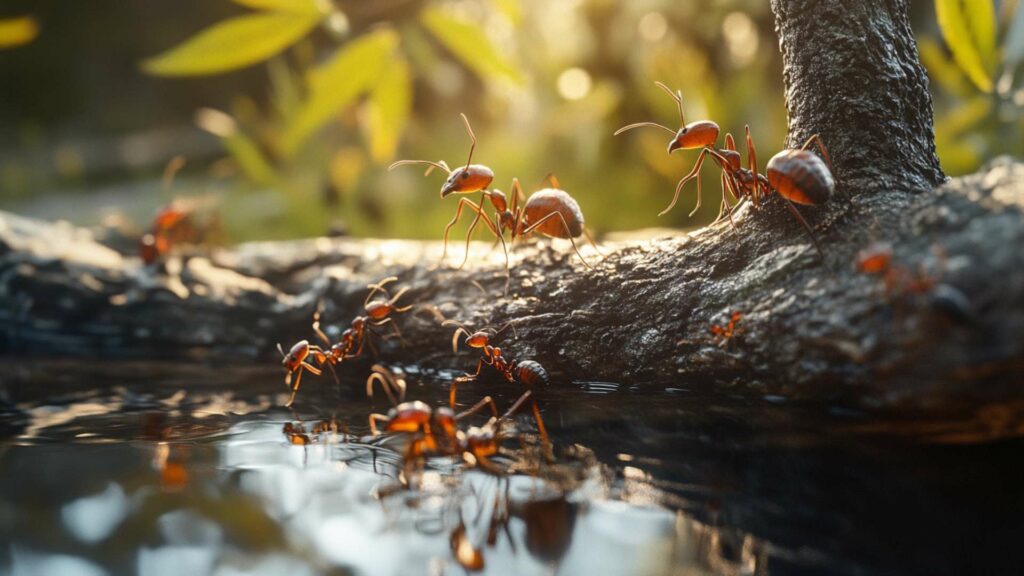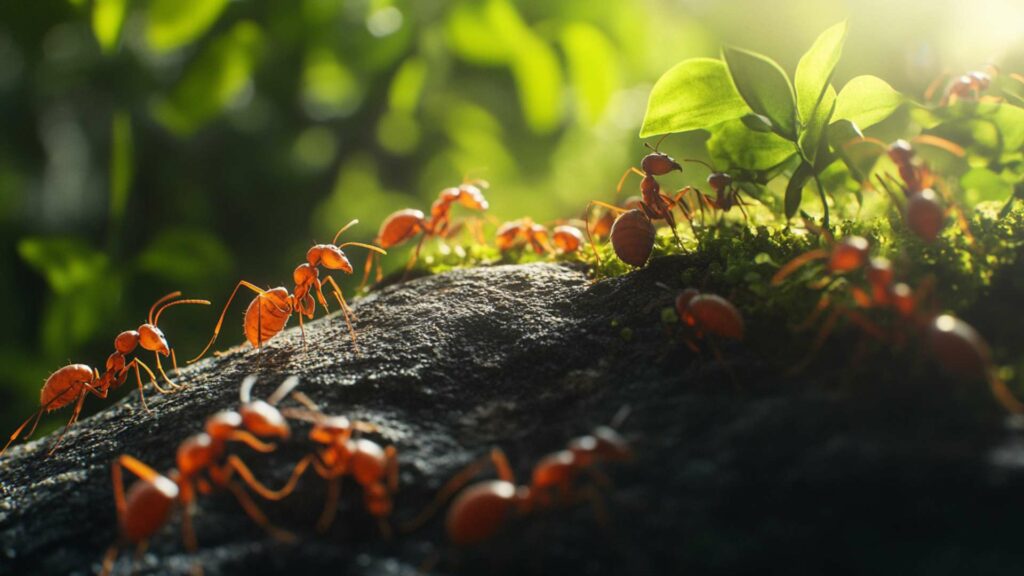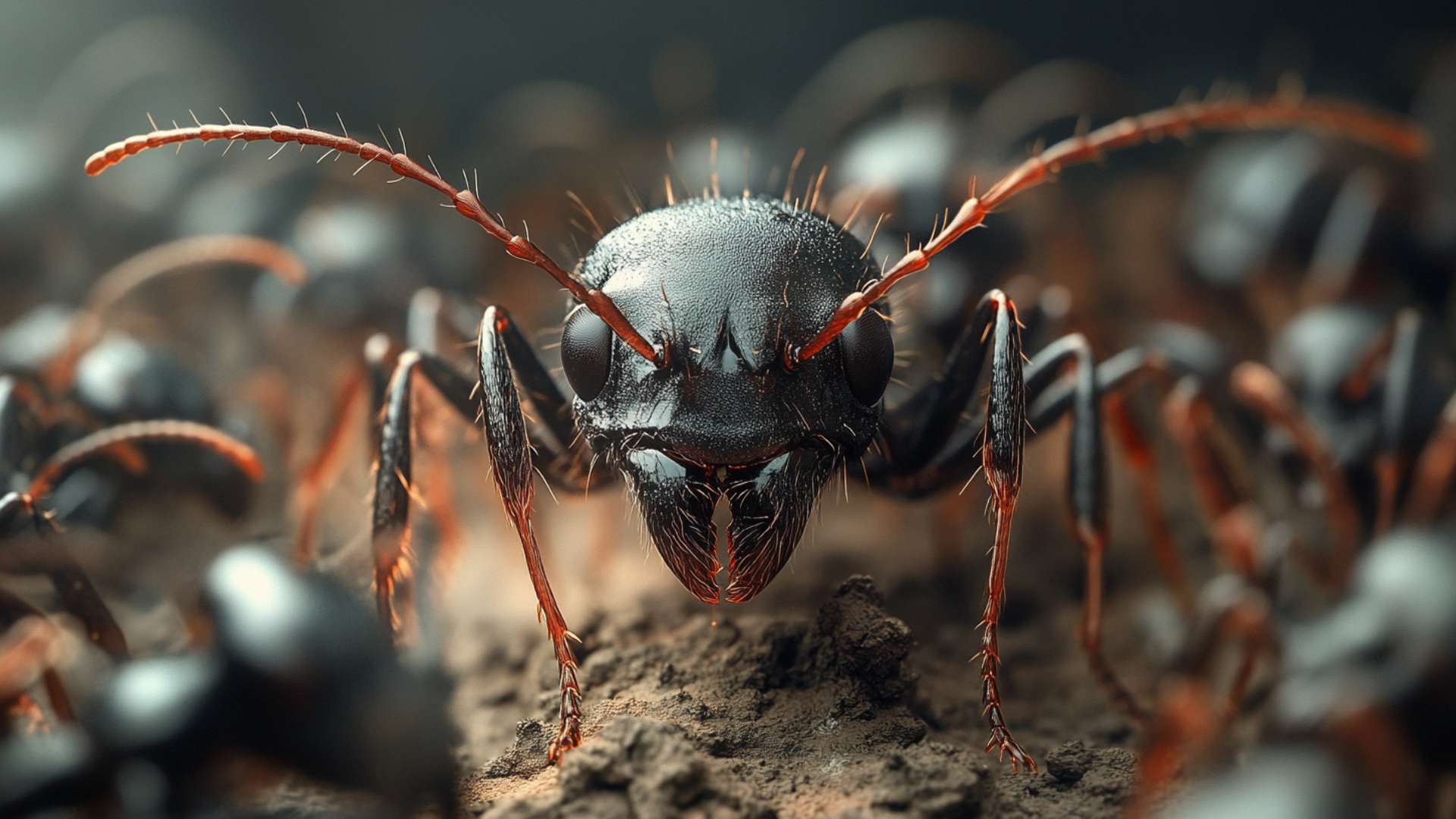Sugar ants, commonly referred to as sugar ants due to their affinity for sweet substances and corn syrup, are a common nuisance in many households. These tiny creatures belong to the ant species known as pavement ants (scientifically called Tetramorium caespitum).
They are usually between 1/8 and 1/4 inch long and vary in color from light brown to black. Sugar ants create their nests in cracks, crevices, or outdoors near foundations.
These industrious little critters have a well-defined division of labor within their colonies. Worker ants are responsible for scouting for food sources, defending the nest from predators, and maintaining the overall order within the colony.
Meanwhile, the queen’s primary role is reproduction; she can lay thousands of eggs during her lifespan. It is essential to understand their behavior patterns when attempting to get rid of sugar ant infestations effectively.
Explanation of Why Sugar Ants Can Be a Nuisance

While sugar ants may seem harmless at first glance, they can quickly become an annoyance when they invade our homes in search of food sources. These persistent little creatures possess an uncanny ability to locate even the tiniest crumbs or spills that we may overlook. Once they discover a reliable food source, they release pheromones that attract other colony members towards it.
The problem arises when this seemingly innocent invasion turns into a full-blown sugar ant infestation. Large numbers of these diligent foragers can contaminate our food supplies and leave behind unsightly trails across our kitchen counters or pantry shelves.
Besides being unsanitary, sugar ant trails can also be quite unpleasant to encounter when we accidentally disturb them. To make matters worse, attempting to eliminate an entire colony can be challenging without proper knowledge or effective methods.
Many store-bought ant repellents contain strong chemicals that may pose health risks, especially if there are children or pets in the household. Therefore, it is crucial to explore alternative solutions and home remedies to address a sugar ant problem safely and effectively.
Identifying Sugar Ant Infestation

When dealing with a potential sugar ant infestation, it is crucial to be able to recognize their presence. One key sign is the sighting of small, dark-colored ants trailing in a line, often referred to as an “ant trail.” These trails can be found both inside and outside your home, leading to their food sources.
Furthermore, if you notice an influx of tiny black insects congregating around spilled food or sweets, it is highly likely that you have a sugar ant infestation on your hands. Another telltale sign is the presence of small mounds of dirt or soil near cracks or crevices in your walls or floors.
Sugar ants tend to create nests and colonies within these secluded areas. You may also spot discarded wings near windowsills or light fixtures as flying ants are usually reproductive members seeking new areas for colonization.
Tips for distinguishing sugar ants from other types of ants
Differentiating sugar ants from other ant species can sometimes be challenging as many share similar physical characteristics. However, there are a few key features that can help you identify them correctly. Sugar ants are typically small in size, ranging from 1/16 to 1/8 inch long.
They have dark brown or black bodies and exhibit a segmented appearance with two antennae protruding from their heads. Unlike some other species like odorous house ants that emit a distinct smell when crushed, sugar ants do not have any noticeable odor.
To further distinguish them from pavement ants, these ants, called sugar ants, -another common household pest – observe their behavior closely. Sugar ant trails usually lead directly towards sources of sweet substances such as spilled soda or sticky countertops.
On the other hand, pavement ant trails may extend outdoors and often involve scavenging for other types of food beyond just sweets. Being able to identify the specific type of ant infestation is vital in determining the most effective approach for eliminating them.
With this knowledge, you can confidently proceed to tackle your sugar ant problem head-on. Remember, proper identification enables you to implement targeted solutions and prevent sugar ants from taking over your home.
Prevention Techniques to Keep Sugar Ants at Bay
Sugar ants, like many other pests, are attracted to food sources left out in the open.
To prevent an ant infestation from taking hold in your home, it’s crucial to maintain cleanliness and practice proper food storage. Start by regularly wiping down surfaces, sweeping floors, and keeping your kitchen free of crumbs and spills.
Those tiny remnants of sugary treats and leftovers can act as a beacon for sugar ants and other pests. When it comes to food storage, consider using airtight containers for all pantry items.
This prevents odors from escaping while also denying access to these tempting treats for sugar ants looking for a free meal. Additionally, ensure that garbage cans have tight-fitting lids and empty them regularly to avoid attracting ants with the scent of rotting food.
Sealing Entry Points to Prevent Ant Access into the House
To successfully keep sugar ants out of your home, it’s important to identify potential entry points and take proactive measures to seal them off.
Start by inspecting windowsills, door frames, cracks in walls or flooring, as well as any gaps around utility pipes or cables entering your home. Use silicone caulk or weatherstripping to seal up these openings effectively.
Pay special attention to areas where you have noticed ant trails or suspect potential entry points. By blocking off these access routes, you’re making it much more challenging for sugar ants (and other pests) to find their way inside.
For larger gaps or holes that cannot be sealed using caulk or weatherstripping alone (e.g., around utility pipes), consider using expanding foam insulation which provides an effective barrier against unwanted intruders. Remember, even the tiniest opening can serve as an invitation for sugar ants to march right into your home.
By implementing these prevention techniques, you are taking proactive steps to keep your home free from annoying pests like sugar ants. Maintaining cleanliness and proper food storage practices will eliminate attractive food sources that may cause sugar ants bite you in the first place.
Additionally, sealing entry points ensures that these persistent critters are denied access to your living space, reducing the risk of an ant infestation. Stay tuned for more effective and natural home remedies to get rid of sugar ants in the subsequent sections of this article.
Natural Remedies for Repelling Sugar Ants
Using Essential Oils to Keep Ants at Bay
Essential oils are not only known for their delightful fragrances but also for their remarkable ability to repel ants. Peppermint oil and lemon oil, in particular, have proven to be effective against sugar ants.
These oils contain powerful compounds that disrupt the ant’s scent trail, making it difficult for them to communicate and navigate effectively. To utilize this natural ant-repellent method, simply dilute a few drops of peppermint or lemon oil in water and transfer the mixture into a spray bottle.
Spritz this aromatic solution along windowsills, doorways, countertops, and any other areas where you’ve noticed ant activity. The refreshing scent will deter ants from crossing these boundaries and discourage their entry into your living space.
Cinnamon and Coffee Grounds: Simple yet Effective Deterrents

If you’re looking for natural solutions that are readily available in your pantry, cinnamon, and coffee grounds can be your allies against sugar ants. These household staples possess properties that make them unappealing to these tiny invaders. Cinnamon acts as an olfactory deterrent due to its strong aroma that confuses the delicate senses of sugar ants.
Simply sprinkle cinnamon powder along ant trails or near entry points to create a barrier they won’t dare cross. Similarly, coffee grounds can disrupt the ant’s pheromone trails since their distinct smell masks the scent markers left behind by scout ants.
Scatter used coffee grounds strategically around areas where you’ve spotted ant activity or along potential entry points like cracks or crevices. Remember that these natural remedies may deter sugar ants temporarily but might not eliminate an extensive infestation completely on their own.
Therefore, it’s crucial to combine these techniques with others mentioned throughout this article for more effective long-term pest control too. Intriguingly, the aromatic nature of these natural deterrents not only helps in repelling sugar ants but can also add a pleasant touch to your living space.
So, why not use them to create an environment that is both inviting to humans and unwelcoming to pesky sugar ants? Stay tuned for the next section where we’ll explore homemade traps and baits that can help tackle those persistent sugar ant colonies!
Homemade Traps and Baits for Sugar Ants
One effective method for getting rid of sugar ants is by setting up bait stations using borax and sweet substances. Sugar ants are attracted to the sweet taste, and by combining it with borax, a common household cleaning agent, you can create a lethal bait that will help eliminate sugar ants from the ant colony.
To make a simple ant killer bait station, mix equal parts of borax and powdered sugar in a small container. Place these containers near ant trails or areas where you have noticed their activity.
The ants will be enticed by the sweet scent, consume the boric acid mixture, and carry it back to their colony. The borax acts as a slow-acting poison that eventually kills off the entire ant colony.
Constructing DIY traps using vinegar or dish soap solutions

Another effective approach to controlling sugar ants in your home is constructing your own traps using vinegar or dish soap solutions. Vinegar disrupts the scent trail that ants use to navigate, making it an excellent natural deterrent.
Fill a spray bottle with equal parts water and white vinegar, then thoroughly spray areas where you’ve seen ant activity or along their trails. This will help repel them from those areas.
Additionally, creating a homemade trap using dish soap can be quite effective at trapping and killing sugar ants. Mix equal parts dish soap and water in shallow containers placed near ant hotspots.
The slippery surface created by the soapy solution makes it difficult for the ants to escape once they fall into the trap. Remember that homemade traps and baits may take time to yield significant results since they target entire colonies rather than individual ants directly.
Be patient and consistent in replenishing the baits until you notice a reduction in ant activity. To ensure success with homemade traps, keep these tips in mind:
– Place the bait stations or traps directly in the path of the ants or near their entry points. – Regularly monitor and replenish the bait as needed to ensure a continuous supply for the ants to feed on.
– Clean up any spills or excess bait, as leaving traces can attract other ants or interfere with the effectiveness of your control methods. – Use caution when employing borax-based baits if you have pets or small children.
While borax is generally safe in small quantities, it’s best to keep it out of reach. By using these simple homemade traps and baits with readily available household items, you can take control of your sugar ant problem without resorting to harsh chemicals.
Chemical Solutions for Eliminating Sugar Ants
When it comes to combating sugar ants, chemical solutions can prove highly effective. Commercially available ant baits and sprays are designed to target sugar ant colonies and eliminate them at their source. These products are widely accessible, easy to use, and offer convenience in managing an infestation.
Ant baits are specifically formulated to attract sugar ants with enticing sweet smells. The bait contains a slow-acting poison that the ants carry back to their nests, ultimately spreading it to the entire colony.
This ensures that not only the visible sugar ants live on your kitchen counter or pantry are eradicated but also those hidden within walls or other unseen areas of your home. Sprays, on the other hand, provide a more immediate solution for eliminating sugar ants on contact.
These insecticides typically contain chemicals that disrupt the nervous system of the pests upon direct application. Spraying along ant trails or near entry points can help deter their movement and prevent further invasion.
Explanation of how these products work to eradicate sugar ant colonies
Ant baits function by exploiting the social nature of sugar ants. These tiny creatures operate within a structured hierarchical system, with workers constantly seeking food or water supply sources to sustain their colony.
When they discover an appealing bait station placed strategically in their path, they carry bits of poisoned bait back to their nest as nourishment for larvae and other members. Once consumed by other ants in the colony, including the queen herself, this slow-acting poison begins its lethal work to kill ants.
It disrupts vital bodily functions within individual ants and gradually spreads throughout the entire population over time. As a result, not only adult workers but also larvae and future generations succumb to its effects.
Sprays act differently by providing instant relief from an infestation without relying on cooperative behavior among ants. These chemicals, when sprayed directly on sugar ants, interfere with their nervous system, causing paralysis and eventual death.
This method proves useful in controlling immediate ant activity and preventing further foraging near treated areas. It’s essential to remember that while chemical solutions can be highly effective in eliminating sugar ants, they should be used responsibly and according to the instructions provided by the manufacturers.
Tips on Locating and Destroying Sugar Ant Nests

Identifying common nesting spots such as cracks, crevices, or outdoor areas
To effectively eliminate sugar ant infestations, it is crucial to locate and destroy their nests. Sugar ants establish their nests in various areas around your home, taking advantage of cracks and crevices to create hidden colonies.
Indoors, start your search by examining the kitchen and pantry areas since these are prime locations for finding food sources. Check along baseboards, under sinks, and behind appliances where you might spot a trail of ants leading back to their nest.
Outdoors, sugar ants tend to make nests in soil near structures or under rocks and logs. Look for small piles of dirt or loose soil that could indicate a possible nest site.
Additionally, keep an eye out for any ant activity near garbage cans or compost bins as these are attractive food sources for sugar ants. By identifying common nesting spots using these tips, you can narrow down the search area and focus on eliminating the source.
Proper techniques for safely eliminating nests without causing harm
Once you have located a sugar ant nest, it’s essential to proceed with caution while eliminating it. Remember that our goal is not only to get rid of the visible ants but also to eradicate the entire colony of dead ants residing within the nest.
For indoor nests situated in cracks or crevices, a highly effective method is using an ant bait. These baits are designed to lure ants away with a sweet treat containing insecticide concealed within it.
Place these baits near ant trails or close to suspected entry points so that the worker ants can carry the bait back to their colony before succumbing to its effects. Outdoor nests require different approaches since they may be larger and more challenging to reach compared to indoor ones.
A helpful strategy involves creating a vinegar solution by mixing equal parts of white vinegar and water. Pour this solution directly into the entrance of the nest, and repeat the process for a few consecutive days.
The strong scent of vinegar disrupts the ants’ pheromone trails, deterring them from returning and eventually leading to the destruction of the entire colony. Remember that both indoor and outdoor nests may contain acrobat ants or other ant species.
Hence, it is crucial to choose elimination methods that are safe for your family, pets, and the environment. By employing these proper techniques for locating and safely eliminating sugar ant nests, you can effectively control their population and prevent future infestations.
Exploring Lesser-known Facts about Sugar Ants
When it comes to sugar ants, understanding their anatomy and behavior can help us tackle those annoying pests more effectively. These tiny creatures, also known as pavement ants or carpenter ants, are typically black or brown in color and range from 1/8 to 1/4 inch in length. They have segmented bodies with three distinct sections: the head, thorax, and abdomen.
Interestingly, sugar ants have a pair of antennae that they use for detecting scents and communicating with other members of their colony. In terms of behavior, sugar ants are social insects that live in large colonies consisting of worker ants, male drones, and a queen ant.
The workers’ main function is to forage for food while leaving behind scent trails that guide other members of the colony towards sources of nutrition. These scent trails play a crucial role in how sugar ants locate food and communicate with each other.
Fun trivia about their ecological role in nature
Did you know that while we may find them a nuisance indoors, sugar the ants live and actually play an important ecological role in nature? These industrious creatures help disperse seeds by carrying them back to their nest as they scavenge for food.
This seed dispersal contributes to the natural regeneration of plants and helps maintain biodiversity within ecosystems. Furthermore, sugar ants are known to consume dead insects or decaying organic matter.
This cleaning service they provide helps prevent the accumulation of waste materials and promotes healthier environments both inside our homes and outdoors. It’s fascinating how these small creatures contribute to the balance of nature even if they can be pesky when they invade our living spaces.
With this newfound knowledge about the anatomy, behavior, and ecological role of sugar ants, it’s evident that there is more than meets the eye when it comes to these tiny creatures. So, the next time you find yourself dealing with a sugar ant infestation, remember to approach the situation with understanding and find ways to resolve the issue without causing harm to these fascinating insects.
Conclusion: Maintaining a Pest-Free Environment
Summary of key points discussed in the article
Throughout this detailed exploration of sugar ants and how to combat their pesky presence, we have learned valuable strategies to maintain a pest-free environment. By understanding the signs of a sugar ant infestation and taking preventative measures, such as keeping our surroundings clean and sealing entry points, we can greatly reduce the likelihood of these tiny invaders making their way into our homes. Our journey has also led us through the realm of natural remedies, where we discovered that essential oils like peppermint can act as effective ant deterrents.
We explored homemade traps and baits using ingredients like borax or vinegar, providing alternative solutions for those who prefer non-chemical approaches. Additionally, we delved into chemical solutions available in the market that effectively eradicate sugar ant colonies.
Never forgetting to remain vigilant, we explored tips on locating and destroying sugar ant nests. By identifying common nesting spots such as cracks, crevices, or outdoor areas, we increase our chances of eliminating entire colonies instead of merely addressing individual ants’ presence.
We ventured into fascinating facts about these minuscule creatures – from their intricate anatomy to their ecological role in nature. By following these guidelines and implementing appropriate measures against sugar ants, not only can we make sure we eliminate these unwanted visitors but also create a positive impact on our living spaces.
Remember to keep pet food properly sealed and avoid leaving sweet foods exposed for extended periods that may attract ants. With determination and persistence, you’ll be able to bid farewell to your ant infestation woes while cultivating an environment free from these persistent nuisances.
Dissuade Ants with D-Termination: Las Vegas’ Foremost Pest Control Service!

If you’re dealing with ant challenges, D-Termination is here to provide assistance. Our experienced team excels at discouraging ants, revitalizing cleanliness, and preserving the integrity of your area. Bid farewell to ants—opt for D-Termination for effective pest control today!
You can reach us at 702-919-6310 or visit dtermination.com to schedule your ant control service and reclaim your space from these unwelcome pests.
Frequently Asked Questions:
Common methods like using ant baits or traps can kill sugar ants relatively quickly.
You can quickly eliminate sugar ants overnight by using bait traps or ant spray near their entry points.
Sugar ants can be resilient due to their large colonies and numerous queens.
While Dawn dish soap may help deter ants, it’s not typically a fast-acting ant killer.








